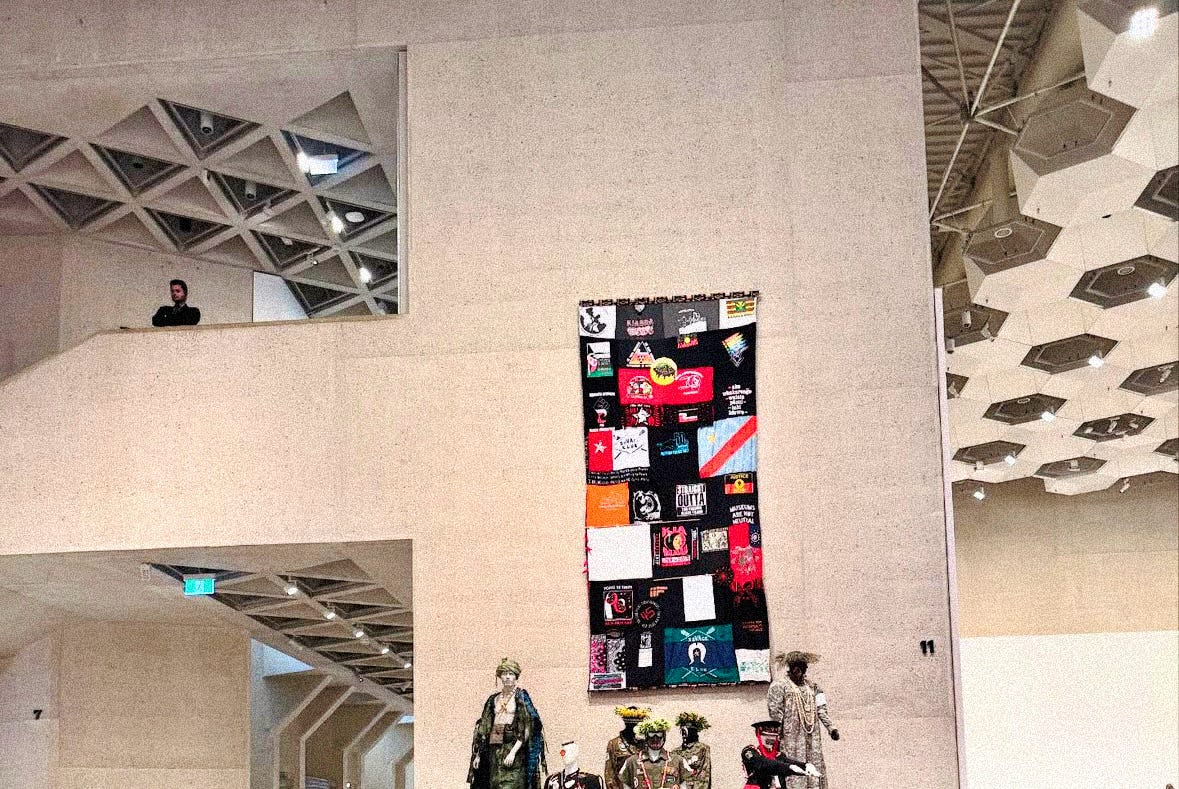Palestinian flags and the NGA
SaVĀge K’lub's censorship
The National Gallery of Australia has censored two Palestinian flags included in a large tapestry as part of its ‘Te Paepae Aora’i — Where the Gods Cannot be Fooled’ exhibition, a group show by Pacific Indigenous art collective SaVĀge K’lub. While the tapestry remains on display, two white fabric flaps have been hung over the flags — a ‘solution’ mutually agreed upon by the NGA and the artists.
While this censorship has received much public backlash, including a sit-in action at the gallery, there are three things that I want to highlight that I feel have been absent from the discourse:
1.
The NGA is not simply an over-cautious or routinely acquiescent organisation. It is an institution operating firmly within the curatorial environment of postmodernism, through which all visual culture is ostensibly permissible fodder for the artist.
The NGA has exhibited many works that certain viewers may find offensive. It recently spent $9.8 million on an artwork by Paul Gauguin, a violent pedophile and serial rapist, who, as a sex tourist in Tahiti took ‘child brides’ as young as 13, infecting them with syphilis. The NGA also has 79 photographs in its permanent collection by Bill Henson, who has built his career on photographing naked children as young as 12.
Over the years, the institution has exhibited many artworks that particular communities may find blasphemous, indecent, amoral or insulting.
Others may simply be offended by the excess and nepotism of the NGA’s commissioning, including the recent $14 million paid for a single artwork made by a friend of the NGA’s director — representing the gallery’s entire acquisitions budget for that year.
I'm not raising these examples here to problematise them individually (although I’d be very happy to), but to highlight the fact that each would have caused offence, at the very least, to a portion of the institution's viewership.
Regardless, the NGA has always — and with its whole chest — defended controversial exhibitions, commissions and acquisitions as having subjective and interpretative artistic value.
By contrast, the Palestinian flag, composed of four basic colours, is the official flag of an actual place. It is a flag easily found in the index of my son's children's atlas. It is ‘offensive’, solely and specifically, to Zionists.
And so the NGA suddenly snaps to attention, immediately discards its supposed commitment to the catch-all permissibility of postmodernism, and hides the flags behind two pathetic little pieces of fabric.
What better symbol of a Zionist's influence, privilege and embarrassing fragility?
2.
The NGA counts John and Pauline Gandel as ‘Visionary Benefactors’. The institution also boasts a ‘majestic venue’ on-site ‘complete with gold-leaf doors and red ironbark floors’ named ‘Gandel Hall’. Make of this what you will.
The Gandels are long time associates of Benjamin Netanyahu and contributed to his rise through Israeli politics. They continue to participate in the Zionist entity’s colonial expansion in Palestine, funding and collaborating with its most violent propagandists and lobbyists.
On 13 October, 2023, just six days into this current iteration of the Zionist entity’s genocidal campaign, John Gandel told the Financial Review that Israel had ‘no choice’ but to go ‘all out’ and ‘hammer’ Gaza.
You can read my text on the Gandels, written in collaboration with Muhib Nabulsi, here.
3.
While the NGA has been rightly criticised for this grotesque act of censorship, the artist’s agency has been largely ignored. SaVĀge K’lub has been overwhelmingly praised for ‘calling out’ the censorship (even while submitting to it). The exhibition’s curator assured The Guardian that SaVĀge K’lub ‘didn’t bend over’ and ‘pushed back’ against the censorship, but ultimately ‘found a solution’ and ‘agreed to a compromise’.
The ‘compromise’, of course, was simply to facilitate the censorship. The group ‘didn’t want to sully the relationship’ with the institution. The ‘solution’ arrived upon was the erasure of Palestine and capitulation to Zionism, while still allowing the NGA to extract cultural and financial capital, and moral cover, from the platforming of an Indigenous collective.
To be clear: there has been no popular call from Palestinians to boycott the NGA, although such a call would clearly be justified. An argument could also conceivably be made that, through its material modification, the artwork itself was transformed into a meta-commentary on the nature of censorship.
Nonetheless, I believe there is a broader conversation to be had about the individual artist’s agency and responsibility when in voluntary and participatory relationship with the inherent Zionism of a colonial institution.
The erasure of Palestinian flags at the NGA is not a distinct or unusual event. Zionists have always understood that the arts are where cultural narratives are created, and can therefore be captured and manipulated. Through their infiltration and exploitation of cultural institutions, Zionists act to suffocate any criticism of their colonial project, and any acknowledgement of Palestinian life.
Zionists also know that artists crave funding, opportunities, audience and acclaim. They know that many of us will capitulate (or even pre-emptively self-censor) in order to gain these platforms, benefits and resources. Add to this a fear of bogus antisemitism accusations, alongside the accumulated decades of racist propaganda, and we begin to comprehend the Australian art industry’s near-universal failure on Palestine.


